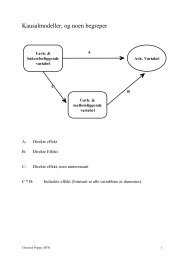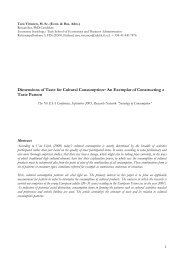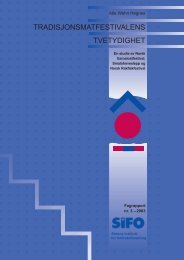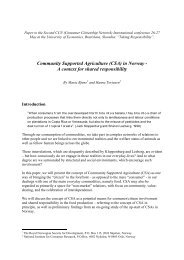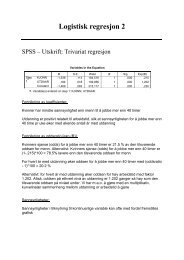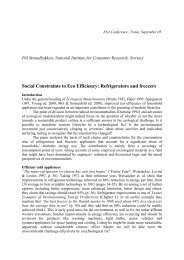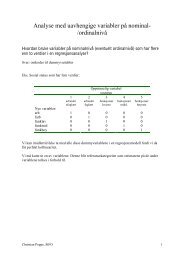an investigation of domestic laundry in europe - habits ... - SIFO
an investigation of domestic laundry in europe - habits ... - SIFO
an investigation of domestic laundry in europe - habits ... - SIFO
You also want an ePaper? Increase the reach of your titles
YUMPU automatically turns print PDFs into web optimized ePapers that Google loves.
Assessment <strong>of</strong> the consumer <strong>laundry</strong> <strong>habits</strong> - a qu<strong>an</strong>titative survey 41wears out clothes. In other words, this factor identifies those who feel thatthere is too much <strong>laundry</strong> be<strong>in</strong>g done.Factor 2 signifies those who highly value cle<strong>an</strong>ness. They strongly agree thatclothes should smell as if newly laundered, that they should be hygienicallycle<strong>an</strong> <strong>an</strong>d that it is embarrass<strong>in</strong>g to wear clothes with a body odour.Factor 3 signifies those who do not take do<strong>in</strong>g <strong>laundry</strong> as seriously, but whow<strong>an</strong>t it to be practical. These respondents feel that today’s detergents are sogood that clothes get cle<strong>an</strong> at low temperatures <strong>an</strong>d that modern detergentskeep clothes white <strong>an</strong>yway.The next step was to <strong>in</strong>vestigate whether different generations have differentorientations. An <strong>in</strong>dex r<strong>an</strong>g<strong>in</strong>g from 3 to 15 po<strong>in</strong>ts was designed, where thelowest number <strong>of</strong> po<strong>in</strong>ts signifies those who do not have this orientation,while the highest score signifies those with the strongest orientation 2 . Scoreswere then compared among the different age groups (table 2-4).Table 2-4 shows that for all countries comb<strong>in</strong>ed, orientations differ betweenthe different age groups. The youngest respondents are less likely to share theop<strong>in</strong>ion that too much <strong>laundry</strong> is done, <strong>an</strong>d it is the middle generation whoshare this op<strong>in</strong>ion most strongly (Factor 1). Factor 2 <strong>in</strong>dicated those whohighly value cle<strong>an</strong>ness. This orientation is stronger among the older generations.Factor 3 signified those who do not seem to take <strong>laundry</strong> as seriously,but w<strong>an</strong>t it to be practical. This orientation is strongest among the oldest generation,reveal<strong>in</strong>g that members <strong>of</strong> this generation are not only the most concernedwith cle<strong>an</strong>ness, but they also have confidence <strong>in</strong> modern detergents<strong>an</strong>d use these <strong>in</strong> a proper way.In summary, attitudes towards <strong>laundry</strong> differ between generations. Members<strong>of</strong> the oldest generation seem to be more concerned with <strong>laundry</strong>; they valuecle<strong>an</strong>ness more highly <strong>an</strong>d are not so <strong>in</strong>cl<strong>in</strong>ed to take <strong>laundry</strong> lightly. Themiddle generation is a bit more <strong>in</strong>cl<strong>in</strong>ed to feel that too much <strong>laundry</strong> is done.And probably this is the generation – the parental generation – which has totake care <strong>of</strong> the most <strong>laundry</strong>.2 For further details see <strong>SIFO</strong> project note [31]




